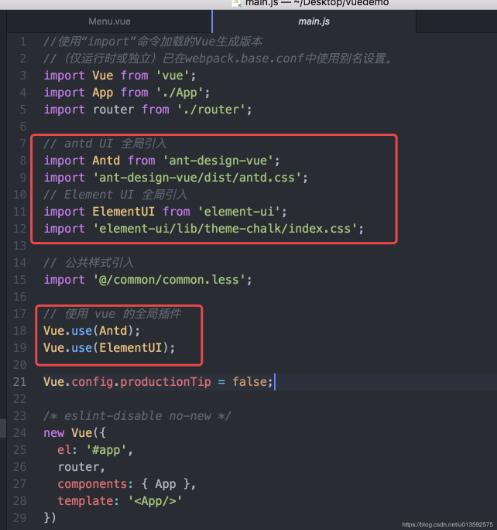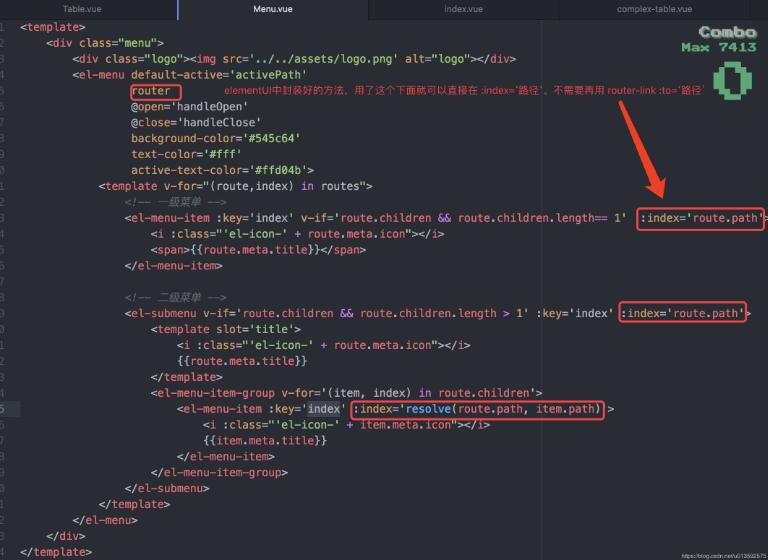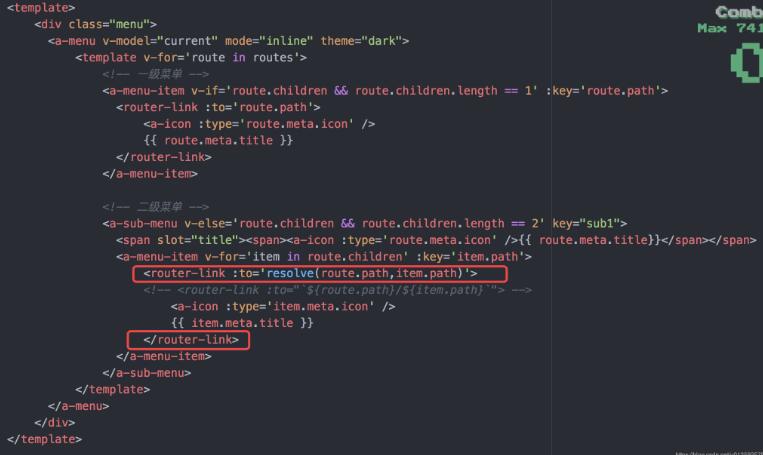通過vue刷新左側菜單欄操作
今天完成了手頭任務就想著做點什么,剛好領導讓我看看項目左側菜單欄不刷新的問題,我也是剛剛接觸vue,很多東西都還不是很熟練,這也是我的第一篇自己寫的博客,感覺還是很興奮的,我覺得寫博客這個習慣要一直養成,不但總結了自己一天的工作所得,而且也是對自己的一種良好習慣的養成。
下面進入正題。
這個是我們html里面的超鏈接,而我們的點擊事件的跳轉就是通過這個超鏈接實現的。
<el-menu-item index='3-1'><a href='http://www.gepszalag.com/bcjs/11103.html#/commodity-list' rel='external nofollow' >
然后我們要創建一個js文件,將我們要跳轉的路徑導入
import ChannelList from ’./src/commodity-manage/channel-list/channel-list’
配置路由管理:
const router = new VueRouter({ routes: [ { path: ’/commodity-list’, name: ’commodity-list’, component: commodityStorage, children: [] }]
path:就是我們要跳轉的路徑
name:跳轉文件的名字
component:配置了映射的組件
在html文件中配置了<router-view/>
<router-view :key='key'></router-view>
是用來渲染通過路由映射過來的組件,當路徑更改時,<router-view> 中的內容也會發生更改
在js文件中使用computed來進行監聽
//每次讓路由生成不同的值,用于重新加載組件,達到刷新數據的效果 computed: { key() { return this.$route.name !== undefined? this.$route.name +new Date(): this.$route +new Date() } },
補充知識:vue:路由菜單(element 和 antd)
在 vue 中 使用 UI框架中的菜單,給菜單如何添加路由呢?其中會出現路由樣式的問題。請看下面兩種UI方法。
注)使用框架的時候注入知道的吧。。。。。防止有些人xxxx,我還是寫一下。

場景:使用 elementUI 的 NavMenu 時。
這里請注意:可以不使用 router-link,在 e-menu 上面綁定 route 或者 :route = ’true’ ,然后遍歷的時候 :index=‘route.path’ (:index=‘路徑’)。

代碼
<template> <div class='menu'> <el-menu default-active=’activePath’ router @open=’handleOpen’ @close=’handleClose’ background-color=’#545c64’ text-color=’#fff’ active-text-color=’#ffd04b’ > <template v-for='(route,index) in routes'><!-- 一級菜單 --><el-menu-item :key=’index’ v-if=’route.children && route.children.length== 1’ :index=’route.path’> <i :class='’el-icon-’ + route.meta.icon'></i> <span>{{route.meta.title}}</span></el-menu-item> <!-- 二級菜單 --><el-submenu v-if=’route.children && route.children.length > 1’ :key=’index’ :index=’route.path’> <template slot=’title’> <i :class='’el-icon-’ + route.meta.icon'></i> {{route.meta.title}} </template> <el-menu-item-group v-for=’(item, index) in route.children’> <el-menu-item :key=’index’ :index=’resolve(route.path, item.path)’> <i :class='’el-icon-’ + item.meta.icon'></i> {{item.meta.title}} </el-menu-item> </el-menu-item-group></el-submenu> </template> </el-menu> </div></template> <script> export default { name: ’Menu’, data() { return { activePath: this.$router.path, } }, computed: { // 計算屬性:獲取路由 routes() { console.log(’test’, this.$router) console.log(’ddd’, this.$router.options.routes) return this.$router.options.routes }, }, methods: { resolve(p,i){ return `${p}/${i}` }, handleOpen(key, keyPath) { console.log(key, keyPath); }, handleClose(key, keyPath) { console.log(key, keyPath); } },}</script> <style lang=’less’> .el-menu { text-align: left; }</style>
場景:使用 antd 的 Menu 時。
這個里面是需要使用route-link做路由跳轉的。

代碼
<template> <div class='menu'> <a-menu v-model='current' mode='inline' theme='dark'> <template v-for=’route in routes’> <!-- 一級菜單 --> <a-menu-item v-if=’route.children && route.children.length == 1’ :key=’route.path’><router-link :to=’route.path’> <a-icon :type=’route.meta.icon’ /> {{ route.meta.title }}</router-link> </a-menu-item><!-- 二級菜單 --> <a-sub-menu v-else=’route.children && route.children.length == 2’ key='sub1'><span slot='title'><span><a-icon :type=’route.meta.icon’ />{{ route.meta.title}}</span></span><a-menu-item v-for=’item in route.children’ :key=’item.path’> <router-link :to=’resolve(route.path,item.path)’> <!-- <router-link :to='`${route.path}/${item.path}`'> --> <a-icon :type=’item.meta.icon’ /> {{ item.meta.title }} </router-link></a-menu-item> </a-sub-menu> </template> </a-menu> </div></template> <script> export default { name: ’Menu’, data() { return { current: [’/’], } }, computed: { // 計算屬性:獲取路由 routes() { console.log(’test’, this.$router) console.log(’ddd’, this.$router.options.routes) return this.$router.options.routes }, }, methods:{ resolve(p,i){ return `${p}/${i}` }, },}</script>
以上這篇通過vue刷新左側菜單欄操作就是小編分享給大家的全部內容了,希望能給大家一個參考,也希望大家多多支持好吧啦網。
相關文章:
1. 怎樣才能用js生成xmldom對象,并且在firefox中也實現xml數據島?2. 基于javaweb+jsp實現企業車輛管理系統3. 利用ajax+php實現商品價格計算4. ASP.Net MVC利用NPOI導入導出Excel的示例代碼5. jstl 字符串處理函數6. JSP動態網頁開發原理詳解7. PHP中為什么使用file_get_contents("php://input")接收微信通知8. XML CDATA是什么?9. IOS蘋果AppStore內購付款的服務器端php驗證方法(使用thinkphp)10. .Net core Blazor+自定義日志提供器實現實時日志查看器的原理解析

 網公網安備
網公網安備